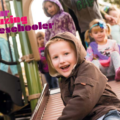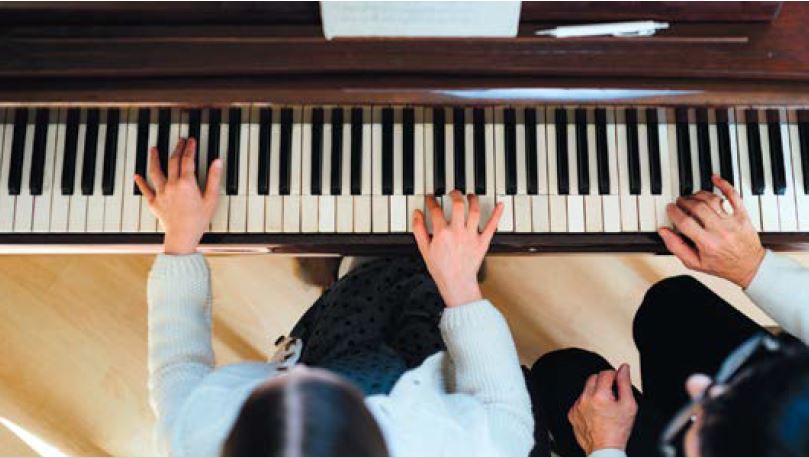“You don’t have to play the guitar, you know,” the photographer said to 15-year-old Donovan Mack.
Sitting on a tall white box, Mack dangled his feet idly as he plucked notes from the instrument.
“I like to,” he said, and the soft melody continued as Will Swanson, also 15, moved around him, snapping his camera, trying to capture different shadows and angles.
Just a few minutes ago, Mack had been hamming it up for the camera, playing with an empty picture frame, as part of their challenge to take portraits indoors.
In another part of the studio, two teenage girls were goofing around with their own photo shoot, giggling and quipping, “cha-ching!” as they snapped portraits.
Nearby, another pair of girls were discussing how they wanted to use the studio’s props for their pictures.
It was all part of a fun-filled morning at the Mpls Photo Center’s summer photography camp for teens.
On this particular day, all the campers were rotating through five different stations to experiment with different lighting set ups.
And that’s actually kind of a big deal: In the smartphone age — in which nearly anyone can attempt art photography and photo editing right on their mobile devices — learning the fundamentals of professional photography (with “real” cameras, which are required here) has become a special thing indeed.
Beyond snapshots
Kids in the center’s half-day, weeklong photography camps first learn how to use their cameras and settings, then they move on to composition, angles, light and even motion, all with a goal of capturing seemingly ordinary things in quite extraordinary ways.
Then they move onto editing and printing, including instruction in Adobe’s Lightroom software, one of the gold standards of professional portrait photographers.
And it all ends with a showcase, featuring students’ work — including self-portraits, motion shots and landscapes — for friends and family to see.
During a camp last summer, props were scattered throughout the center’s spacious warehouse — including professional studio equipment, a sofa and a giant fan one pair used give a wind-swept look to their portraits, to name a few. Campers set a soundtrack by DJing with their favorite musical genres, including pop, country and instrumental.
Richard Guttmann, the instructor of the camp, made the rounds as pairs of students tried out different equipment, giving suggestions on lighting, angles, lenses and composition.
“If you want it to look like a tall angle,” he advised one camper, “I would shoot from below for that extreme perspective play off.”
Finding their vision
The different scenarios — plus the campers’ imaginations — created vastly different portraits and self-portraits in the end. There was a shot of a teen boy, jumping up from a couch, pushed onto the set as a prop; a close-up of a pensive teen girl; yet another girl, looking out from underneath an umbrella, its stem dividing her face perfectly in half between light and shadow.
“They all come up with their own concepts,” Guttmann said. “I always tell them: It’s all about your vision. Nothing is really wrong.”
One of the guitar photos of Mack was Swanson’s favorite of the day — a black and white close-up of the guitar with the fretboard fading away like a road in the distance.
Swanson would get to show off the image, along with his other favorites, during the last day of summer camp in the concluding exhibition.
Editing, printing, discovery
Although the Mpls Photo Center boasts both Apple computers and Epson printers as well as one of the only public darkrooms left in Minnesota, its summer camps are less about the technical process and more about the creative journey and the tools photographers can use to bring ideas to life.
“Before [digital] there was so much emphasis on the technique — the shooting and the processing,” said Jeff Harrington, the director of the center. “Now that time and energy and effort to go into creativity.”
At camp, only about 15 minutes of each half-day is reserved for lecturing and examples. The rest — at least 75 percent — is devoted to taking photos, followed by a half-hour or so reserved for uploading and editing images. (The only exception is the last day when the campers take more time to do their final edits, printing and set up for their exhibitions.)
With 10 kids attending this particular camp session, it was easy to find many different photography styles and viewpoints. But the campers all agreed photography allowed them see the world in different ways.
“The biggest thing,” said 15-year-old camper Rosie Letofsky, “is you take a photo and get a captured feeling. It’s a moment, an experience, that you can re-experience.”
Teen photography camp
In these weeklong, half-day camps, ages 12 to 16 learn — from professional photographer Richard Guttmann — how to control camera functions and capture photos in a fun, hands-on way. They also receive instruction in Adobe’s Lightroom software and digital printing, all culminating in a showcase featuring students’ work
for friends and family to see.
Ages: 12–16
Dates: Five-day camps are offered the weeks of June 12, 19, 26; July 10, 24; and Aug. 8. Participants can choose from morning or afternoon sessions.
Previous photography experience isn’t required. Students must bring their own digital single-lens reflex (DSLR), mirrorless or compact digital cameras. Camera rentals are available.
Hours: 9 a.m.–12:30 p.m. or 1:30–5 p.m.
Location: Mpls Photo Center, 2400 N. Second St., Minneapolis
Cost: $295 per week
Info: mplsphotocenter.com
Lianna Matt is a Twin Cities journalist who loves traveling and meeting people on the job — even if she is a bit directionally challenged.




















